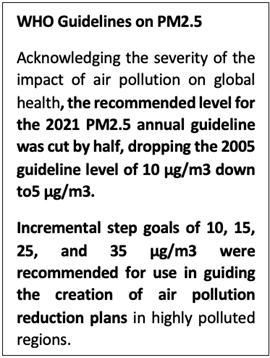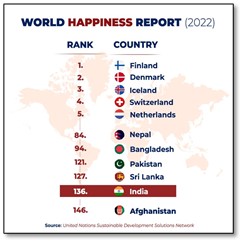Friday, 25th March 2022
GSAT 7B satellite
In News
Indian Army is set to get a dedicated communication satellite GSAT-7B from ISRO
About the News
- Ministry of Defence has recently approved the Acceptance of Necessity for GSAT-7B Satellite which was a long-awaited dedicated military communication satellite demand by Indian army.
- The satellite will enhance operational preparedness of the Armed Forces and boost its communication capabilities.
- Apart from the communication satellite, the Defence Acquisition Council also accorded its nod to the procurement of Night Sight (Image Intensifier), Light Vehicles GS 4X4 and Air Defence Fire Control Radar (Light) that will provide better visibility, enhanced mobility, improved communication and increased capability of detecting enemy aircraft.
- It is seen as an impetus to ‘Aatmanirbhar Bharat’ as all of these proposals have been approved under the ‘buy (Indian IDDM)’ category with a focus on indigenous design & development and manufacturing in India.
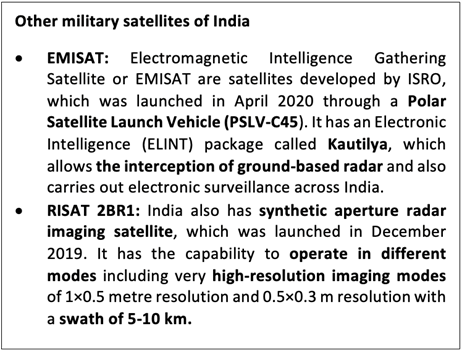
What are the GSAT 7 series satellites?
- About: GSAT 7 satellites or Rukmini are advanced satellites developed by the Indian Space Research Organisation (ISRO) to meet the communication needs of the defence services.
- Weight: It is a 2,650 kg satellite which was launched in August 2013 from an Ariane 5 ECA rocket from Kourou in French Guiana.
- Range: The satellite has a footprint of nearly 2,000 nautical miles in the Indian Ocean region. This satellite is mainly used by the Indian Navy for its communication needs.
- Features: The satellite carries payloads in UHF, C-band and Ku-band, and helps the Navy to have a secure, real time communication link between its land establishments, surface ships, submarines and aircraft.
- Orbit: The satellite was injected into a geosynchronous transfer orbit (GTO) of 249 km perigee (nearest point to earth), 35,929 km apogee (farthest point to earth) and an inclination of 5 degree with respect to the equator.
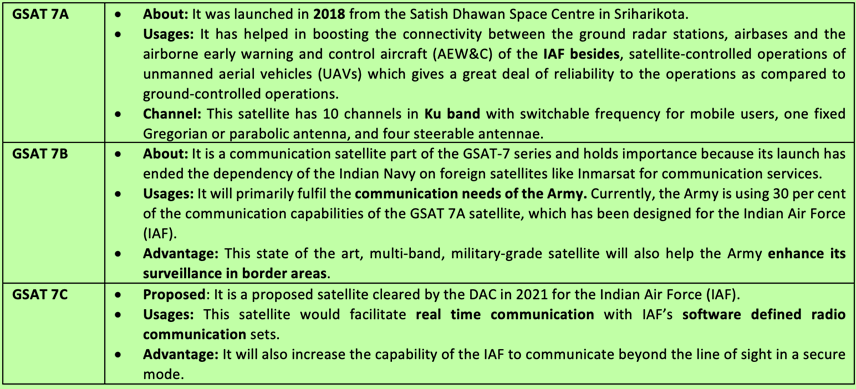
Sources:
Workforce Lacking Digital Skills
In News
Consulting firm AlphaBeta has released a report, ‘Building Digital Skills for the Changing Workforce’ based on a study commissioned by Amazon Web Services, Inc. (AWS).
Key insights from the report
- The report aims to better understand the need for digital skills of the workforce across Australia, India, Indonesia, Japan, New Zealand, Singapore, and South Korea.
- The ability to use cloud-based tools, such as cloud developer tools, as well as online collaboration, accounting, and customer relationship management (CRM) software will be the most in-demand skill required by employers by 2025 followed by technical support and cybersecurity skills.
- Cloud computing is on-demand access, via the internet, to computing resources—applications, servers (physical servers and virtual servers), data storage, development tools, networking capabilities, and more—hosted at a remote data center for a fee.
- Compared to traditional on-premises IT, cloud computing offers lower costs, improved agility, easier scalability, more speed, better productivity, reliability, performance and security.
- Employers and workers understand the looming digital skills crunch.
- The report found that 93% of organizations and workers faced barriers to accessing the digital skills they needed.
- The two most common barriers are the limited awareness of training options available and a lack of time to pursue training.
- The public and private sector can meet the digital skills challenge. Governments can work with industry to develop micro-skills training courses to help workers upskill quickly to broaden their employment opportunities and bridge skills gaps.
- There is a need to provide training to underserved communities, including women, at-risk youth, unemployed individuals, rural communities, and low-skilled migrant workers, as these groups tend to face greater challenges in accessing digital skills training opportunities.

How India fares?
- 95% of workers in India reported that they need more digital skills to cope with changes in their jobs due to the Covid-19 pandemic as there was an increased digital transformation seen in all organisations.
- The report found that over the next year, the number of India workers requiring digital skills for their jobs is projected to increase by 27.3 million, representing 7% of India’s workforce.
- Despite this, only 45% of employers in India have a training plan in place, which could affect their competitiveness in such areas as productivity, innovation, and employee retention.
Sources:
The Ahir Regiment
In News
A recent and an ongoing agitation by the members of the Ahir community has disrupted traffic on a 6-kilometre stretch of the Delhi-Gurgaon highway.
About the News
- The protest is with respect to the demand of an Ahir Regiment in the Indian Army.
- This demand is in the backdrop of the Ahirwal region (that includes the southern Haryana districts of Rewari, Mahendragarh, and Gurgaon, and which is associated with Rao Tula Ram, the Ahir hero of the revolt of 1857), having traditionally contributed soldiers to the Indian Army in large numbers.
- Also that the Ahir troops of Haryana are known for their bravery in the Battle of Rezang La in 1962.
- Ahirs are recruited in the Indian Army in various regiments including fixed class regiments like Kumaon, Jat, Rajput, and mixed class regiments like the Brigade of the Guards or The Parachute Regiment in the Infantry and various other regiments, and in Corps like Artillery, Engineers, Signals, and Army Service Corps.

Army’s response to the demand
- The Army has rejected the demand for any new class or caste based regiment.
- It has said that while the older regiments based on castes and regions like the Dogra Regiment, Sikh Regiment, Rajput Regiment, and Punjab Regiment will continue, no new demands on the lines of an Ahir Regiment, Himachal Regiment, Kalinga Regiment, Gujarat Regiment or any tribal regiment would be entertained.
- This is because the Indian army has been doing well with the present composition and therefore any new regiment based on class or caste will hamper its Indian nationalist character.

Source:
Christiaan Huygens
On March 25, 1655, Christiaan Huygens, a Dutch astronomer, inventor, physicist and mathematician, discovered Saturn’s largest moon, Titan. Nearly 350 years later, his namesake, the Huygens probe, landed on that moon to learn more about it. Once spotted, Titan was easy to observe, and Huygens also determined its period of revolution. It was named Titan almost two centuries later by Sir John Herschel, since the name corresponded to something large, powerful, and very important. Huygens is also considered the founder of the wave theory of light. Huygens was also the inventor of the pendulum clock. He was able to bring down the error from about a minute every day to less than ten seconds a day by improving the clock.

Sources:
Port Sector in India
In News
The Economic survey 2022 has recommended steps to improve performance of port infrastructure in India.
Status of ports in India
- India is the sixteenth-largest maritime country in the world and with a coastline of about 7,517 kms, maritime transport is a key constituent to the trade and economic growth in India, contributing 90% in terms of volume and 77% in terms of value.
- India has 12 major and 200 non-major/intermediate ports (under state government administration). Jawaharlal Nehru Port Trust is the largest major port in India, while Mudra is the largest private port.
- India is one of the world's top 5 ship recycling countries and olds 30% share in the global ship recycling market..
- In the Indian scenario, though there has been an impressive growth of container traffic of over 15 per cent per annum over the last five years, it is far less compared with international trends.
- India plays a marginal role in the export of maritime transport services with a less than one per cent share of world market.
- The growth in traffic has exceeded the growth in capacity leading to congestion and low productivity, making the Indian Maritime sector unattractive.
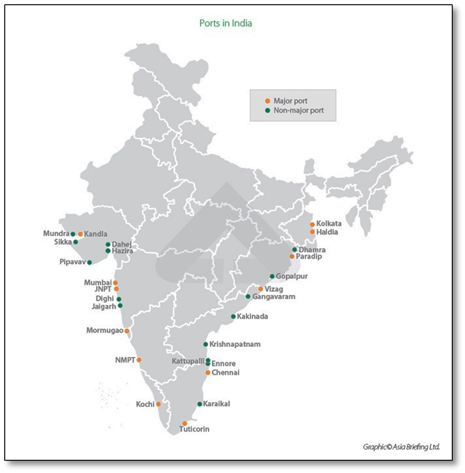
What is the potential of ports in India?
- Capacity: India’s key ports had a capacity of 1,534.91 million tonnes per annum (MTPA) and handles 60 million tonnes (MT) of cargo traffic annually.
- Merchandise exports: India’s merchandise exports grew 43.05% YoY to reach US$ 290.63 billion in FY21.
- FDI: Indian ports received cumulative FDI inflow worth US$ 1.63 billion in last twenty years.
- Mega-SEZ: Jawaharlal Nehru Port Trust (JNPT) Special Economic Zone (SEZ) became the first of its kind operational port-based multi-product SEZ in India.

What are the Challenges faced by the Ports in India?
- Logistics Bottleneck: The lack of expressway connectivity between major ports as well as industrial clusters, and high fuel cost make hinterland transportation inefficient and slow.
- Also, the container freight stations and business need to be organized efficiently through good management practice in space utilization, adoption of technology for track and trace, etc.
- Technology Bottleneck: Though all major ports in India have implemented (not fully) EDI (Electronic Data Interchange) and online tracking systems, the information exchange amongst the major trading / operational partners, such as customs, ports, inland terminals and shippers involved in container trade is limited.
- Regulation Bottleneck: The custom procedures and regulations, and lengthy documentation process are the other areas where Indian maritime sector lags the pace when compare with its counterparts like Singapore, China, and Malaysia.
- Labour issues: Major Indian ports are bogged with frequent labor strikes, consequently, congestions, inefficiency and lower productivity at their respective ports. The port labor federations and unions are very powerful in India.
Government efforts to support Port Industry
- Technology upgradation: Government has introduced new Radars and Vessel Traffic Management System in phased manner in major ports starting with Cochin Port Trust.
- Sagarmala project: It is the flagship programme of the Ministry of Shipping to promote port-led development in the country and enhance the performance of the country's logistics sector
- Maritime vision 2030: It identifies 150+ initiatives across various maritime sectors like ports, shipping and waterways. It envisions an overall investment of INR 3,00,000-3,50,000 Cr across ports, shipping, and inland waterways categories. It is estimated to help unlock INR 20,000+ Cr worth of potential annual revenue for Indian Ports and is expected to create an additional -20,00,000+ jobs (direct and non-direct) in the Indian maritime sector.
- Draft Indian Ports Bill 2021: It aims to centralise the administration of minor ports that are currently managed by state governments.
- Inland Vessels Bill 2021: It aims to include a single legislation for the country. The registration certificate issued under the new law will be valid throughout the country and state approvals will not be necessary. The bill also establishes a single database for recording vessel and crew information on an Internet portal.
- Ship recycling: Ministry of Finance has proposed to double the ship recycling capacity of ~4.5 million light displacement tonnes (LDT) by 2024; this is expected to generate an additional ~1.5 lakh employment opportunities in India.
- Other Initiatives:
- Marine Aids to Navigation Bill 2021: It aims to incorporate global best practices, technological developments and India's international obligations in this field.
- Maritime heritage: Ministry of Ports, Shipping and Waterways and Ministry of Culture have signed an MoU for cooperation in development of Heritage Complex at Lothal, Gujarat.
- Reducing time: Steps taken to reduce turnover time and pre – berthing time came down further from 7 days in 2002 to 03 to 5 hours, Indian ports are still a long way to go to reach the world standard.
- Public-private models: Government to develop seven projects worth more than Rs. 2,000 crore (US$ 274.31 million) on a public-private partnership basis in FY22. Private sector investments in ports have steadily increased over the last five years, touching an all-time high of US$ 2.35 billion by 2020.
- Chabahar port: India is expected to begin full operations in Iran’s Chabahar Port and is building two terminals at the port to operate them for 10 years.
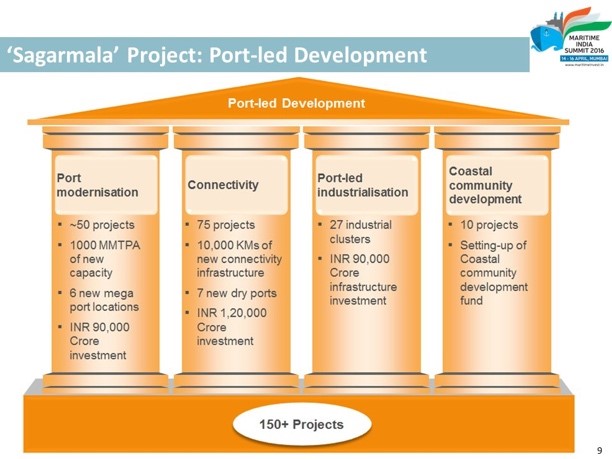
What more can be done?
- Public and Private participation: It is the only solution for the financial bottleneck that Indian ports are facing to modernize their facilities and infrastructures to the world standard level.
- Removing regulation bottlenecks: Government should streamline the project processes and procedures and ensure the level playing field among the terminal operators.
- Cluster approach: Government should link all major ports and Industrial cluster places with expressway to ensure a streamline movement of goods between different entities.
- Single window clearance: Port Authorities should introduce a single window clearance and a single paper clearance for pre / post shipment procedures and benefits. EDI should be implemented fully and should be integrated with other trading partners, and should ensure 24 × 7 Operations and online customs clearance.
- Congenial work environment: Government including all stakeholders should strive to create a holistic work environment among labor, operators, authorities and so on and develop standard code of conduct to all ports, which would reduce the misunderstandings between terminal operators and labor.
Question: Discuss the role played by ports in the development of economy in India. Why has India not been able to utilize the full potential of its ports?
Sources:
Chamayavilakku ritual
This is image of men dressed up as women offer prayers as part of the Chamayavilakku festival at Kottankulangara Devi Temple in Kollam, Kerala. Chamayavilakku is also a much-anticipated event for the members of transgender community, as it offers them an opportunity to celebrate their real identity. As part of the unique temple ritual, men dress up as women offer prayers to the presiding deity. According to the temple legend, a bunch of cowherds tried to break a coconut by hitting it on a stone, which suddenly started bleeding. It was found by astrologers that the stone contained divine energy of Vanadurga and the locals were instructed to build a temple around it. It is believed that the first poojas of the temple were conducted by the cowboys wearing the clothes of women, which eventually led to the unusual custom.
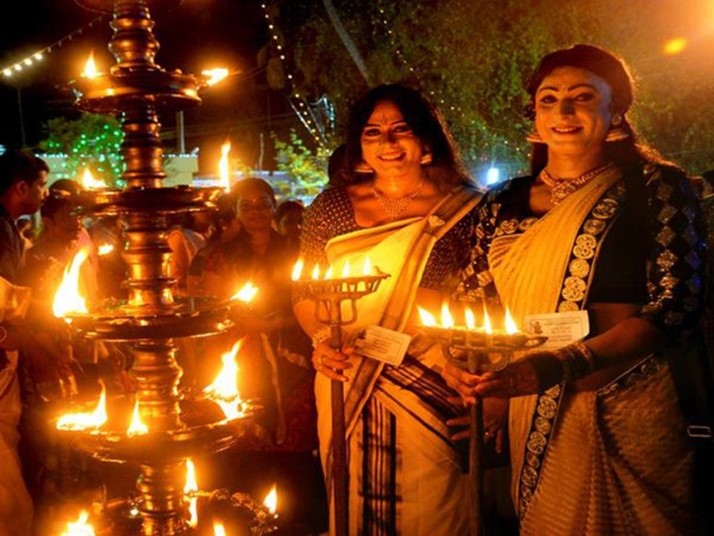
Source:
League of Arab States
- Context: Recently, a UNSC meeting was held on cooperation between the United Nations and the League of Arab States (LAS).
- Indian Foreign Secretary said that India and the Arab world share a “civilisational relationship”
- Arab League, also called League of Arab States (LAS) is regional organization of Arab states in the Middle East and North Africa.
- It was formed in Cairo on March 22, 1945, following adoption of the Alexandria Protocol in 1944 (agreement signed by five Arab countries agreeing to the formation of a joint Arab Organization)
- It aims to be a regional organization of Arab states with a focus to developing the economy, resolving disputes and coordinating political aims.
- The founding member states of the League are Egypt, Syria, Lebanon, Iraq, Transjordan (now Jordan), Saudi Arabia, and Yemen.
- The Other members include Libya (1953); Sudan (1956); Tunisia and Morocco (1958); Kuwait (1961) etc.,
- Each member has one vote on the League Council and the decisions are binding only on those states that have voted for them.
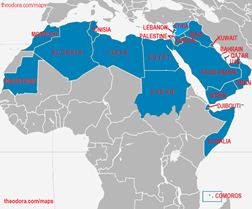
Source:
- Foreign Secretary Shringla calls for alignment between UN, League of Arab States
- League of Arab States
Image source:
Centre to study Human Brain
- Context: The IIT Madras has recently launched a centre to generate and study human brain data.
- The centre will focus on high-resolution brain imaging and has an ambitious project to map human brain at the cellular and connectivity level.
- The clinical partners for the project will be medical teams led by doctors and will have six internationally renowned faculty as visiting professors at the institute.
- The first ongoing project of the Centre is titled ‘Computational and Experimental Platform for High-Resolution Terapixel Imaging of ex-vivo Human Brains’ for high-throughput light microscopic imaging of whole human brains.
- Through this project, the Centre has developed a high-throughput histology (the study of the microscopic structure of tissues) pipeline that processes whole human brains into high-resolution digital images.
- Using this technology platform, the Centre is imaging post-mortem human brains of different types and ages.
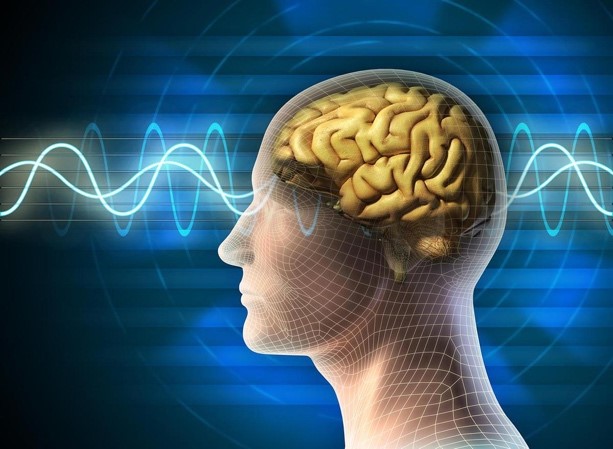
Source:
- IIT-Madras sets up centre to study human brain
- IIT-Madras sets up centre to map human brain at cellular level
Image source:
MSP of Raw Jute for 2022-23
- Context: The Cabinet Committee on Economic Affairs (CCEA) has recently approved minimum support price of raw jute for 2022-23 season.
- Minimum Support Price (MSP) is a form of market intervention by the Government of India to insure agricultural producers against any sharp fall in farm prices.
- It is announced by the Government of India at the beginning of the sowing season for certain crops based on the recommendations of the Commission for Agricultural Costs and Prices (CACP) and is approved by the Cabinet Committee on Economic Affairs (CCEA).
- The MSP of Raw Jute has been fixed at ₹4,750 per quintal for 2022-23 season with an increase of ₹250 over the previous year which would ensure a return of 60.5% over all India weighted average cost of production.
- The announced MSP is in line with the principle of fixing the MSP at a level of at least 1.5 times all India weighted average cost of production as announced by the government in Budget 2019.
- It assures a minimum 50% as margin of profit. It is one of the important and progressive steps towards ensuring better remunerative returns to jute growers and to incentivise quality jute fibre.
- The Jute Corporation of India (JCI) is the nodal agency that undertakes price support operations and any loss incurred in such operations will be fully reimbursed by the Centre.
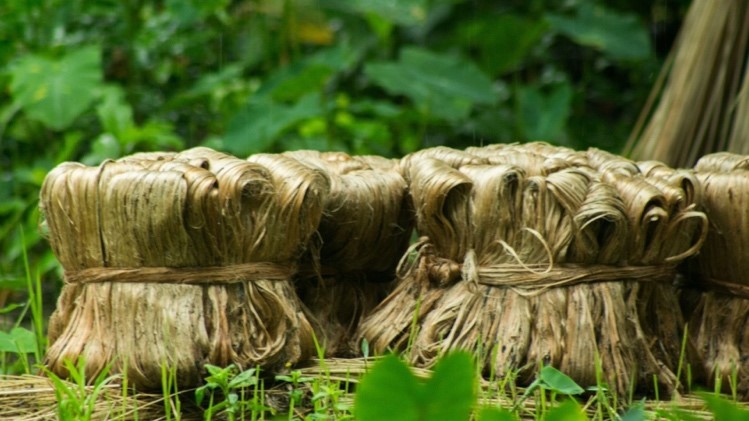
Source:
Image source:
Minamata Convention
- Context: At the ongoing Minamata Convention at Bali, India has sought time till 2030 to phase out linear fluorescent lamps or tube lights to reduce adverse effects of mercury.
- The Minamata Convention on Mercury is a global treaty to protect human health and the environment from the adverse effects of mercury.
- It was agreed at the fifth session of the Intergovernmental Negotiating Committee in Geneva, Switzerland 2013.
- The key obligation of the convention includes controlling the anthropogenic release of mercury throughout its lifecycle and addressing interim storage of mercury and its disposal once it becomes waste, health issues associated with mercury contaminated sites etc.
- Countries that have ratified the Convention are bound by international lawto put controls on mercury mining, manufacture and trade of mercury and products containing mercury, disposal of mercury waste and emissions of mercury from industrial facilities.
- India has ratified the Minamata Convention.
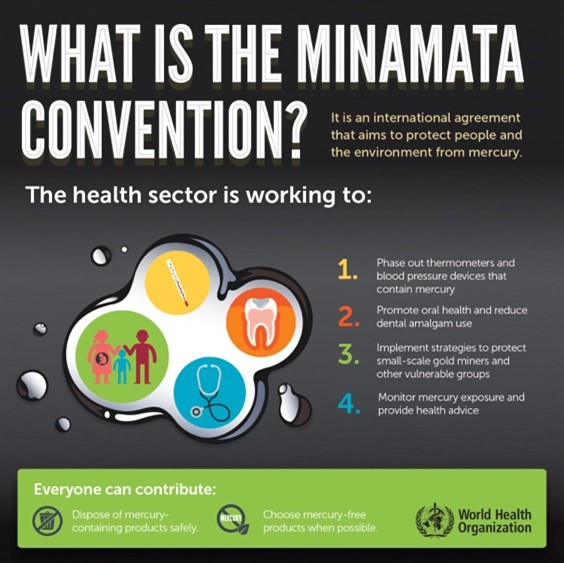
Source:
Image source:
The effect of farm sector changes on agrarian movements in India: LM
Essence: The article talks about the fact that the farmers need to gain solidarity if they wish to increase their collective bargaining power. Despite the agitation over the three farm bills, farmers failed to generate in any political consensus on most of the farm issues. The underlying reason for the same is the changed nature of agriculture. There is change in cropping pattern across the states along with monetisation of agricultural inputs.
Another major change is an increase in capital intensity and recourse to mechanisation leading decline in use of farm labour. All of these factors have led to most of the farmers seeking employment elsewhere, weakening the solidarity among the wage workers and cultivators. If the famers want to create a political impact, they need to build coalitions across different class of farmers. With growing uncertainties in the market farmers need to come together. They also need to attain a stronger bargaining position to protect agriculture, farmers and rural economy.
Why you should read this article?
- To understand why the famers were not able to bring the political consensus with respect to farm laws.
- To understand the changing nature of agriculture in India in last three decades.
- To understand what steps the farmers should take to increase their collective bargaining power.
Source:
A war within a war: Sexual violence as a weapon of war: ORF
Essence: Throughout history, sexual violence against women and girls has been used as a weapon in conflicts to humiliate, oppress, and terrorise communities as a result of the breakdown of institutions and social networks. Example- Sexual violence is being utilised as a weapon of war in Tigray by both Ethiopian and Eritrean forces, according to the majority of genocide academics and rights organisations. Majority of sexual abuse survivors suffer from serious health problems resulting, most sexual assault survivors have gotten little or no care. The consequences of sexual violence during fights, such as HIV, psychological problems, and vilification, frequently last long after the fight is over. However, the Ethiopian catastrophe raises some serious concerns about the global goal of oriented correspondence, SDG 5, which asks for "ending viciousness towards women and young women in public and private spaces, especially dealing and sexual and other forms of abuse." There is an urgent need to increase pressure on the Ethiopian government to honour its obligations to basic rights and to condemn the sexual brutality in Tigray.
Why should you read this article?
- To understand how the issues sexual violence against women and girls has been used as a weapon in conflicts and what are its implications?
- To know what possible steps, we should take to address the same.
Source:
Time for India to redefine its relationship with Russia: TH
Essence: The editorial highlights the Russia-Ukraine war as the time for evolving and redefining the world order and strategic balance in international relations. USSR has supported India navigate through times of distress during cold war period when the western countries sided with Pakistan several times against India. India too has repeatedly supported Russia’s stand by abstention and no criticism for acts of war. However, the future is seen in a different light.
Unprecedented sanctions on Russia will collapse Russian economy and draw it closer to mighty China’s military and economic orbit. China’s actions, on the other hand, have only exacerbated India’s fear at border areas. In these circumstances, it is only the western economies (USA, Europe, etc.) which would support India’s Indo-Pacific policies, something Russia is critical of.
The present realities indicate how Russia has converted from superpower to bully, its declining position in emerging world order, and how USA could be the most likely ally to advertise India as a great future power. It is in this regard that India must learn to evolve its non-alignment strategy to multi-alignment with major powers.
Why should you read this article?
- To understand the issues with Russian aggression and how it impacts India.
- To know the strategic possibilities for international relations in evolving times.
Source:
Malarvizhli Akka
Background
Malarvizhli Akka from Chennai had been working towards revival of a natural pond to end the decades of woes of a village around the pond.
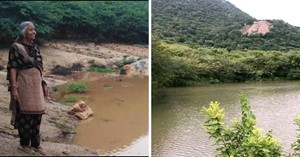
About Malarvizhli Akka
- Akka, which refers to sister, is what Malarvizhli was fondly addressed by the villagers of the Chinnapallikuppam village, Chennai. She died in 2019.
- The village suffered from water scarcity leading to crop failure and distress among the farmers.
- A vivid environmentalist and social worker herself, Malarvizhli Akka learned about the village and its condition.
- She engaged fellow environmentalist and nature lovers to contribute to the conservation drive in the village through a WhatsApp group named Pakirvu, meaning ‘sharing’ in Tamil.
- She educated the villagers regarding diversification of agriculture instead of monocropping. She also educated the villagers regarding invasive species.
- She worked on the revival of a dried-up pond through hydrological assessment. Today, the pond has a storage capacity of 6 crore litres and has led to prosperity in the village.
Quote: “Not too late to save water’s fate.” – The Dharma Trails
Source:
Share the article
Get Latest Updates on Offers, Event dates, and free Mentorship sessions.

Get in touch with our Expert Academic Counsellors 👋
FAQs
UPSC Daily Current Affairs focuses on learning current events on a daily basis. An aspirant needs to study regular and updated information about current events, news, and relevant topics that are important for UPSC aspirants. It covers national and international affairs, government policies, socio-economic issues, science and technology advancements, and more.
UPSC Daily Current Affairs provides aspirants with a concise and comprehensive overview of the latest happenings and developments across various fields. It helps aspirants stay updated with current affairs and provides them with valuable insights and analysis, which are essential for answering questions in the UPSC examinations. It enhances their knowledge, analytical skills, and ability to connect current affairs with the UPSC syllabus.
UPSC Daily Current Affairs covers a wide range of topics, including politics, economics, science and technology, environment, social issues, governance, international relations, and more. It offers news summaries, in-depth analyses, editorials, opinion pieces, and relevant study materials. It also provides practice questions and quizzes to help aspirants test their understanding of current affairs.
Edukemy's UPSC Daily Current Affairs can be accessed through:
- UPSC Daily Current Affairs can be accessed through Current Affairs tab at the top of the Main Page of Edukemy.
- Edukemy Mobile app: The Daily Current Affairs can also be access through Edukemy Mobile App.
- Social media: Follow Edukemy’s official social media accounts or pages that provide UPSC Daily Current Affairs updates, including Facebook, Twitter, or Telegram channels.


